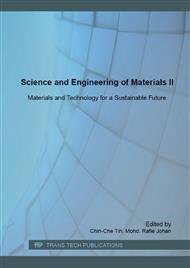[1]
J.E. Mark, B. Erman and F.R. Eirich, The science and technology of rubber, 3rd Ed., Elsevier Academic Press, New York, 2005, chapter 9, pp.421-427.
Google Scholar
[2]
B. Adhikari, D. De and S. Maiti, Reclamation and recycling of waste rubber, Progress in Polymer Science, 25 (2000) 909-948.
DOI: 10.1016/s0079-6700(00)00020-4
Google Scholar
[3]
L. Laurence, M.L. Christopher, S.A. Norman, E. Michele, F. Thompson and S.W. Robert, Use of microwave dielectric loss spectroscopy for characterization of natural rubber/carbon black composites. Polymer Bulletin, 44 (2000) 187-194.
DOI: 10.1007/s002890050591
Google Scholar
[4]
J. Dobozy, Method and apparatus for recovering an elastomeric material, United States Patent, 6, 722, 593. (2004).
Google Scholar
[5]
G.G. Wicks, R.L. Schulz, D.E. Clark and D.C. Folz, Microwave treatment of vulcanization rubber, United States Patent, 6, 420, 457. (2002).
Google Scholar
[6]
V. Bovtun, W. Stark, J. Kelm, V. Porokhonsky and Y. Yakimenko, Microwave dielectric properties of rubber compounds undergoing vulcanization, KGK-Kautschuk und Gummi Kunstststoffe, 54(12) (2001) 673–678.
Google Scholar
[7]
D. Bogdal, P. Penczek, J. Pielichowski and A. Prociak, Microwave assisted synthesis, crosslinking and process of polymeric materials, Advances in Polymer Science, 163 (2003) 193–263.
DOI: 10.1007/b11051
Google Scholar
[8]
L. Landini, S.G. Araújo, A.B. Lugão and H. Wiebeck, Preliminary analysis to BIIR recovery using the microwave process, European Polymer Journal, 47 (2007) 2725–2731.
DOI: 10.1016/j.eurpolymj.2007.03.017
Google Scholar
[9]
C.Y. Khor, Z.M. Ariff, F. Che Ani, M. Abdul Mujeebu, M.K. Abdullah, M.Z. Abdullah and M.A. Joseph, Three-dimensional numerical and experimental investigations on polymer rheology in meso-scale injection molding, International Communications in Heat and Mass Transfer, 37(2) (2010).
DOI: 10.1016/j.icheatmasstransfer.2009.08.011
Google Scholar
[10]
N. Makal and P. Rattanadecho, Microwave pre-cure of natural rubber compounding using rectangular wave guide, International Communications in Heat and Mass Transfer, 37 (2010) 914-923.
DOI: 10.1016/j.icheatmasstransfer.2010.03.001
Google Scholar
[11]
A.C. Mataxas, R.J. Meridith, Industrial microwave heating, Peter Peregrinus, Ltd. London, (1983).
Google Scholar
[12]
A.C. Peter, N. Hewitt, The rubber formulary, Noyes Publications, Norwich New York, USA, (1999).
Google Scholar
[13]
P. Rattanadecho, Influences of irradiation time, particle sizes and initial moisture content during microwave drying of multi-layered capillary porous materials, Journal ASME Heat Transfer, 124(1) (2002) 151–161.
DOI: 10.1115/1.1423951
Google Scholar
[14]
H. Schbert, M. Regier, The microwave processing of foods. Cambridge: Woodhead, (2005).
Google Scholar
[15]
P. Rattanadecho, K. Aoki and M. Akahori, A numerical and experimental investigation of the modeling of microwave drying using a rectangular wave guide, Drying Technology an International J., 19(9) (2001) 2209-2234.
DOI: 10.1081/drt-100107495
Google Scholar


